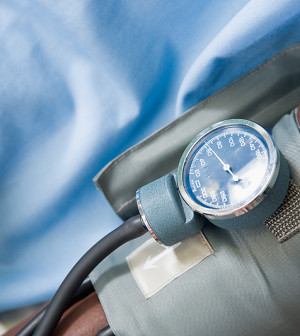- Navigating Your Midlife Crisis: Embracing New Possibilities
- City Raccoons Showing Signs of Domestication
- Mapping the Exposome: Science Broadens Focus to Environmental Disease Triggers
- One Week Less on Social Media Linked to Better Mental Health
- Your Brain Changes in Stages as You Age, Study Finds
- Some Suicide Victims Show No Typical Warning Signs, Study Finds
- ByHeart Formula Faces Lawsuits After Babies Sickened With Botulism
- Switch to Vegan Diet Could Cut Your Greenhouse Gas Emissions in Half
- Regular Bedtime Does Wonders for Blood Pressure
- Dining Alone Could Mean Worse Nutrition for Seniors
New Blood Pressure Guidelines a Danger to Patients: Study

Scientists continue to debate when doctors should prescribe blood pressure medication for older Americans, with a new study saying delayed treatment puts people at greater risk of stroke.
For people 60 and older, a U.S. panel in 2014 recommended raising the blood pressure rate at which doctors prescribe treatment from 140 to 150 systolic blood pressure. Systolic blood pressure is the top number in a blood pressure reading.
But the new study finds that people with systolic blood pressure of 140 to 149 have a 70 percent increased risk of stroke compared to people with lower blood pressure.
“Our study shows the borderline group is probably as risky as having a blood pressure greater than 150, at least for stroke risk,” said senior author Dr. Ralph Sacco, chair of neurology at the University of Miami Miller School of Medicine. “This was a controversial move, and I think our study suggests we shouldn’t switch it to 150. We should stick to 140.”
The new findings, published online Feb. 1 in the journal Hypertension, are unlikely to quell arguments over proper blood pressure management, however.
For instance, the new study does not address the risk of side effects associated with blood pressure medications, or how medication would alter a person’s overall stroke risk, said Dr. Paul James, head of family medicine at the University of Iowa Carver College of Medicine.
“It’s a matter of balancing the risk of treatment with the benefits of treatment,” said James. “That’s not a simple thing, and it’s not really something that one study like this study could answer.”
About one in three adults in the United States has high blood pressure (or “hypertension”), according to the U.S. National Heart, Lung, and Blood Institute.
The institute formed the Eighth Joint National Committee, or JNC8, in 2008 to update high blood pressure treatment guidelines issued in 2003. Its final recommendation, issued in 2014, said that adults aged 60 or older should only take blood pressure medication if their blood pressure exceeds 150/90, a higher bar of treatment than the previous guideline of 140/90.
Arguments immediately sprang up around the JNC8 revised guidelines, with the American Heart Association expressing concern over potential delays in treatment of high blood pressure.
“These were extremely controversial, and the American Heart Association was adamant and vocal in our disagreement with that,” said Dr. Mary Ann Bauman, a heart association spokeswoman. Bauman is the medical director of women’s health and community relations at Integris Health in Oklahoma City.
Sacco and his colleagues launched their new study in response to the JNC8 recommendations. “We were concerned about the recommendations’ potential effect on stroke prevention,” he said.
The research team gathered data on 1,750 participants aged 60 and older in the Northern Manhattan Study, a study of stroke risk in a multi-ethnic community. None had diabetes or chronic kidney disease — two risk factors for stroke.
During about 13 years of follow-up, 182 people suffered a stroke, the investigators reported.
The researchers concluded that having a systolic blood pressure of 140 to 149 elevated stroke risk as much as having systolic blood pressure greater than 150. Increased stroke risk was most notable among Hispanics and blacks, the findings showed.
“Our findings support adherence to current American Heart Association treatment guidelines,” Sacco said. It recommends starting medication at 140 systolic or higher.
James responded that the new study does not provide solid evidence that would refute the JNC8 recommendation, which called for doctors to treat borderline blood pressure (140-149 systolic) through lifestyle factors such as diet and exercise.
He added that the new study is based on observational data, and can only draw associations about stroke risk. The JNC8 recommendations were based on clinical trials that proved that stricter guidelines and tighter blood pressure control provided no additional benefit to patients, James said.
“But the evidence told us going below 150 did not seem to translate into improved health or improved mortality,” James said.
Bauman countered that the clinical trials the JNC8 relied upon didn’t give a full picture of the long-term risks of high blood pressure.
“The complications of hypertension are long, long range, and I don’t think the clinical trials they relied on went long enough,” Bauman said.
Bauman and Sacco also pointed out that a new clinical trial called SPRINT, which came out after the JNC8 guidelines, has shown that driving blood pressure down to as low as 120 systolic can reduce by one-quarter the rate of death, heart attack, heart failure and stroke.
Paul agreed that the SPRINT trial “rises to that degree of evidence” that the JNC8 sought, and should be included in any future review of blood pressure guidelines.
More information
To learn why blood pressure matters, visit the American Heart Association.
Source: HealthDay
Copyright © 2025 HealthDay. All rights reserved.










